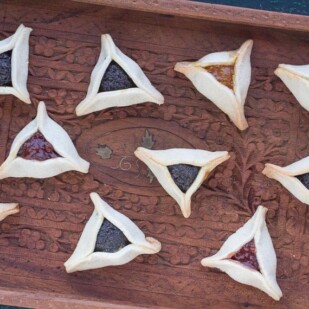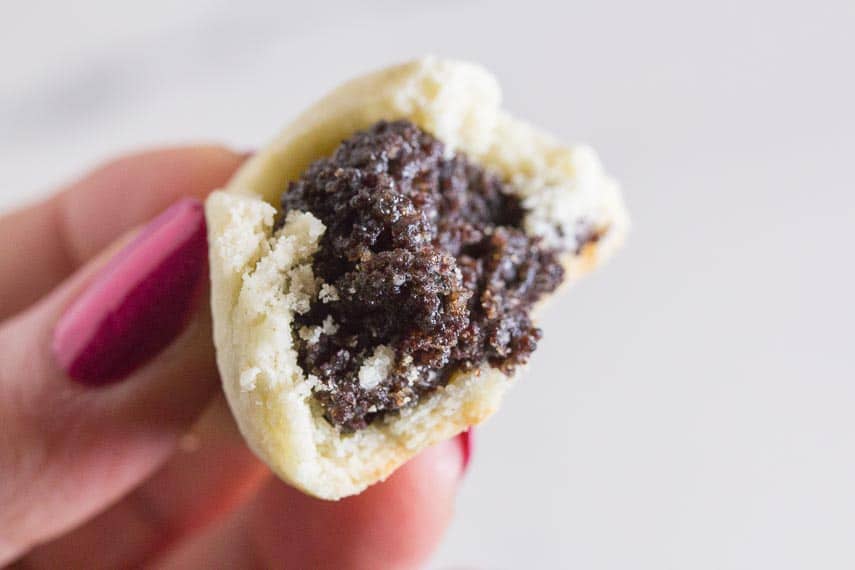Learn to Make Low FODMAP Gluten-Free Hamantaschen
These were a long time in coming. I have been eating and baking gluten-free for decades, and yet, never got around to developing a Low FODMAP Gluten-Free Hamantaschen. Well, finally, at long last, here they are!
And I have to tell you – it takes a lot for me to be pleased with myself. These poppy Hamantaschen took me back to my childhood, when my Jewish Nanas and Aunts were baking for me, and these are even better than I had hoped for!

Classic Hamantaschen for Purim
Some resources say that the first mention of hamantaschen appear in Machzor Vitry, an eleventh century prayer book from France. These cookies (which are arguable a pastry) are made for Purim, a joyous holiday that actually marks a dark history.
The Persian Jewish population was facing genocide at the direction of an evil advisor to the King, named Haman. The Jewish community prevailed due to some brave and smart machinations of Queen Esther and her cousin Mordecai.
Purim is actually quite celebratory and a lot of wine and food is shared and consumed, particularly foods with stuffings (like savory kreplach, as well as sweet hamantaschen) and generous amounts of wine.
For hamantaschen the classic filling is poppyseed, although prune and plum, particularly the rich, sticky prune lekvar, often makes an appearance. Prune is high FODMAP, so I didn’t provide that option.
The triangular shape of the cookie is usually described as being reminiscent of Haman’s hat, and yet the term “hamantasch” actually means Haman’s pocket. Now before you think it is odd that we have a celebrated pastry named after a villain, think of it this way: we are eating a part of Haman and therefore dispatching him! Quite tastily.
After almost throwing in the butter-stained towel after our low FODMAP Rugelach recipe went down in history as the most difficult recipe I have ever had to wrangle, I was a tad afraid of a similar experience with hamantaschen.
Luckily, these came together in a fairly straightforward manner. So much so that it emboldened me to use more than one filling. One, of course, had to be poppy seed and that filling is included here, below.

Poppy Seeds Are Low FODMAP
I LOVE poppy seed filling in coffee cakes and pastries. When I was a little girl, my Great Auntie Anna made the most incredible yeast pastries and I always went for the prune filled, which I called “prunies”, as well as those with poppy seed.
They were exotic to me and unlike anything else I typically came across. We saw her every summer, but never during other times of the year, so these treats were events of my formative culinary childhood years and I cherish them dearly.
And, Monash has lab tested poppy seeds and deems them to be low FODMAP and Elimination safe at 2 Australian tablespoons (24 g). The filling in each hamantaschen contain much less.
While you can fill hamantaschen with all kinds of fillings, I do suggest that you make the poppy seed filling. The recipe for the cookie-like dough will make about 36 hamantaschen, so you can certainly fill some of them poppy and some of them with other flavors, if you like.
The best fillings are rather thick. You can use a thick strawberry jam or orange marmalade, as I have shown in the images.
Using Jam & Marmalade As Filling
Any filling used needs to be quite thick. I find boiling down jams and marmalades a little bit and then refrigerating overnight improves their texture for use as a filling.
Also note that these fillings will be quite sweet.
Monash has now lab tested raspberry jam, so if you like you could choose from strawberry, raspberry or orange marmalade.
Xanthan Gum is Low FODMAP
There are certain times when working with a gluten-free dough that the inclusion of xanthan gum makes the difference between a dough being workable and easy to roll and not working at all – crumbling apart and resisting the rolling pin. This is one of those dough recipes.
Xanthan gum, and guar gum for that matter, are low FODMAP, so they are not an issue from a FODMAP perspective. As usual, I like this recipe prepared with Bob’s Red Mill 1 to 1 Gluten Free Baking Flour, which does contain xanthan gum, and is my favorite GF blend.
If you substitute another flour, it must contain xanthan gum. But please use what is recommended for best results.
Honey is Low FODMAP in Small Portions
Honey has been lab tested to be Low FODMAP in 1 teaspoon amounts. That is a tiny amount, but honey has a very pronounced – and beloved – flavor and the addition of 1 tablespoon to the filling creates a very traditional result.
If you stick with our serving size recommendations, our hamantaschen are low FODMAP.
You might like to read about Apples & Honey for Rosh Hashanah, from a FODMAP perspective.
If you think you might be indulging in many holiday dishes, be sure to read our article on FODMAP Stacking at Holiday Meals.
And speaking of holidays, we have several Passover and Hanukkah recipes for you to enjoy.

Low FODMAP Gluten-Free Hamantaschen
Our Low FODMAP Gluten-Free Hamantaschen are so incredibly delicious, you will think you are back at the Jewish bakery! Classic poppy seed filling, too.
Low FODMAP Serving Size Info: Makes about 36 Hamantaschen; serving size 1 Hamantaschen
Ingredients:
Hamantaschen Dough:
- ¾ cup (1 ½ sticks; 170 g) unsalted butter, at soft room temperature, cut into pieces
- 2/3 cup (131 g) sugar
- 1 teaspoon vanilla extract
- 1 large egg
- ¼ teaspoon salt
- 2 1/4 cups (326 g) low FODMAP gluten-free all-purpose flour, such as Bob’s Red Mill 1 to 1 Gluten Free Baking Flour
Poppy Seed Filling:
- 1 cup (152 g) poppy seeds, ground in a coffee mill or spice grinder
- ½ cup (120 ml) lactose-free whole milk
- 1/3 cup (65 g) sugar
- 1 tablespoon honey
- 1 teaspoon lemon zest
- 1 teaspoon orange zest
- ½ cup (83 g) raisins, light or dark, chopped
- 1 teaspoon lemon juice
- ½ teaspoon vanilla extract
- 1 large egg, for assembly, very well beaten
Preparation:
-
For the Hamantaschen Dough: Beat the butter with an electric mixer or in a stand mixer fitted with a flat paddle (my preference) on medium-high speed until smooth and creamy. Add the sugar and beat on medium-high speed until well creamed and combined, scraping down bowl as needed. Beat in vanilla then beat in egg until incorporated. Add the flour in 2 or 3 batches and beat on low speed, then increase speed to medium and beat until very well combined and the dough comes away from the sides of the bowl somewhat cleanly. Don’t worry about overworking the dough; make sure it is combined thoroughly and the dough is coming away from the sides of the bowl. Divide into two portions, shape into flat discs and wrap in plastic wrap. Refrigerate at least 2 hours or overnight.
-
For the Poppy Seed Filling: Place the ground poppy seeds in a small saucepan and stir in the milk, sugar, honey, lemon and orange zest. Cook over low heat, stirring frequently, and bring to a simmer until thickened, about 5 minutes. Stir in raisins, distributing them well within the mixture, and cook for another minute or two. Remove from heat and stir in lemon juice and vanilla extract. Cool slightly, then refrigerate in an airtight container overnight or at least until very firm. It should hold its shape when scooped up with a spoon. This makes about 1 ¾ cups (385 g) of filling, which is enough to fill all of the hamantachen.
-
Assemble the Hamantaschen: Position oven racks in upper and lower third of oven. Preheat oven to 350°/180°C. Line 3 half-sheet baking pans with parchment paper and set aside.
-
Remove dough from fridge and allow to stand at least 5 minutes at room temperature. Then work it with your hands, kneading it, until you have a smooth, elastic, but still somewhat chilled ball.
-
Roll out on a very lightly flour dusted surface to 1/8-inch (3 mm) thick (thin!) If the dough is cracking at all, gather it up and knead it a bit more. This dough is ALL about temperature and rolls like a dream when you hit it right. If you are having problems, chances are it is still too cold. You can also roll out between lightly flour dusted parchment paper, if you find that more helpful.
-
Cut out rounds with a straight-edge 3-inch (7.5 cm) cookie/biscuit cutter. Brush the edges of the dough rounds with the beaten egg. Place 2-teaspoons of filling in the center of each dough round (I use a tiny little scoop that I also use when making truffles).
-
Bring one part of the dough edge up and against the filling, then bring up the other “sides” creating as equilateral a triangle as possible. Firmly pinch together the 3 corners of your Haman’s hat! If the dough is cracking at all at this point, it is because it is too cold.
-
Bake for about 20 minutes, two pans at a time (don’t try and crowd three racks and trays in at once) rotating the pans halfway through. The cookies should be very lightly tinged with color. Cool completely on pan set on cooling rack. Store cookies in single layers in airtight containers for up to 4 days.
Notes:
Tips
- If the dough is cracking when you tried to create the corners, it is simply too cold. Let its rest a few moments (or minutes) and try again.
Nutrition
All nutritional information is based on third-party calculations and should be considered estimates. Actual nutritional content will vary with brands used, measuring methods, portion sizes and more. For a more detailed explanation, please read our article Understanding The Nutrition Panel Within Our Recipes.










Hi, do you have any recommendations for dairy free butters that could work for baking cookies?
We have a vegan article in the pipeline, which is going to address this. I will cut and paste part of it for you here: “… if a recipe was developed and tested with chicken eggs, butter and cow’s milk and you substitute chia eggs, margarine or oil and an alt milk, we can guarantee that the recipe will not come out as originally intended and therefore you are entering the world of custom recipe development yourself.” So, big caveat that our recipes are tested as written an we cannot vouch for substitutions. You could try Earth Balance buttery sticks but I have no idea how the work-ability of the hamantaschen dough will be.
Great recipe, dough tastes amazing for being GF! I didn’t use the poppyseed, rather bought marmalade’s from the market. Fresh organic apricot was my favorite.
PROBLEM I RAN INTO: Dough was still too crumbly, even after coming to room temp.
SOLUTION: I had to add about 2-3 Tablespoons of water to get the dough to workable consistency.
Hope that helps 🙂 Happy Purim
Hi there! We have made the recipe several times as tested. I bet it is a measurement issue with the flour, but so glad you found a work around.